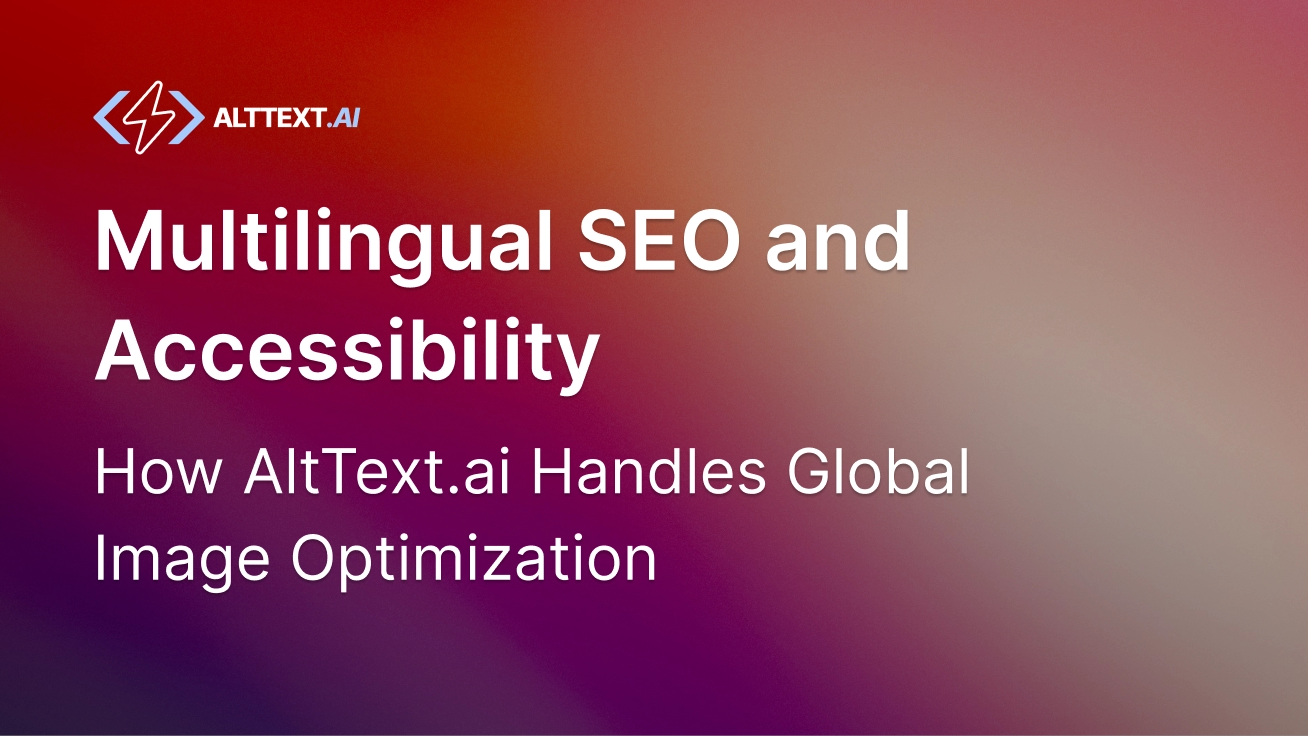
Multilingual SEO & Alt Text Accessibility: Global Image Optimization Guide
Transform your global presence with AI-powered multilingual alt text that drives international SEO success and ensures worldwide accessibility compliance.
When we analyzed traffic from brands using multilingual alt text, we found something striking: sites gained about 19% more organic visits from overseas markets. This guide walks through what we learned while generating alt text in 136 languages—and why the payoff is bigger than most people expect.
What's new?
NewWith a recent update, AltText.ai can write alt text in several languages in one go—no extra clicks. Pick any of the 130-plus languages we support, from French and German to Japanese, and we'll create every version in a single pass.
Why multilingual alt text matters in 2025
Research shows 75% of people prefer browsing in their native tongue. Leaving your images English-only puts up needless barriers. Once your alt text speaks more than one language you'll notice:
- More eyes on your images: Baidu, Yandex, Naver and other local search engines start surfacing your content
- Instant compliance: Pages meet WCAG 2.1 requirements across every region
- Longer visits: International users stay 47% longer on sites with native-language content
- Higher conversions: E-commerce stores often see 20–25% better conversion when images are localized
Audit Your Global Accessibility Gap First
Before implementing multilingual alt text, run a free Website Accessibility Analyzer to understand exactly how many images across your site are missing alt text—so you know the scope of your international opportunity.
Language coverage
We currently support 136 languages—enough to reach virtually any market. The full list includes:
That reach means you can talk to almost any audience while staying on the right side of accessibility law. Curious about the nuts and bolts? See our multilingual support guide for a step-by-step tour.
Pricing in plain English
Because each language equals one credit, describing a single image in five languages costs five credits.
Here's what that looks like in practice:
- A boutique with 50 products in English, Spanish and French needs 150 credits
- An enterprise catalog of 1,000 images published in six languages uses about 6,000 credits
- A 500-product store serving 10 EU markets comes in at roughly 5,000 credits
Plan your subscription around total image-language pairs. With tighter accessibility deadlines approaching, covering every market you serve has never been more important.
What works best (lessons from thousands of roll-outs)
- Think local, not just linguistic. Cultures read visuals differently, so tailor descriptions.
- Match your brand voice. Germans expect formal; Americans like casual.
- Generate fresh, don't just translate. Native descriptions beat direct translations every time.
- Batch it. Feed your whole library at once—e.g.,
["en", "es", "fr", "de", "ja"]—instead of image-by-image. - Plug into your CMS. On WordPress, setup with WPML or Polylang is quick.
- Mind platform quirks. Shopify gives you one alt-text field, so prioritize your top market.
Real-world win: a fashion brand goes pan-European
A sustainable clothing label selling only in the UK needed reach across Europe, but its images lacked local-language metadata. They pushed 2,500 product photos through AltText.ai, generating fresh alt text in English, French, German, Italian and Spanish. After 30 days:
- European (non-English) organic traffic rose 19%
- Google Images click-through rates tripled
- 100% WCAG compliance across regional sites
- About €15k saved versus human translators
- Product launches now go live 87% faster
"This completely changed how we think about international SEO. We're on page one for sustainable-fashion terms in five languages." — Head of Digital Marketing
Frequently Asked Questions
How many languages can AltText.ai handle?
We're at 136 and counting—including English, Spanish, French, German, Chinese, Japanese, Arabic and dozens of regional tongues.
Does writing alt text in multiple languages cost extra?
Yes—one language equals one credit. If you need alt text for 100 images in five languages, you'll spend 500 credits. Most brands find the extra international traffic easily covers the cost.
How is native-language alt text different from a plain translation?
Native descriptions are written from scratch for that audience, not word-for-word copies. We see engagement climb roughly a third because the phrasing fits local search habits.
Can I plug AltText.ai into my existing CMS?
Absolutely. On WordPress, WPML or Polylang setup takes minutes. Shopify, Webflow and most other builders recognize our multilingual alt text out of the box. Custom stack? Our API is ready.
How long does generation take?
Whether you choose one language or twenty, each image usually finishes in 2–5 seconds—far faster than translating one by one.
Audit Your Global Accessibility Gap First
Before launching multilingual alt text across your global sites, run a free Website Accessibility Analyzer to identify how many images currently lack descriptions. See the full scope of what needs optimization.
Ready to Optimize Globally?
Try multilingual alt text with your first 25 images free. Join international brands using AltText.ai to improve accessibility and SEO across 130+ languages.